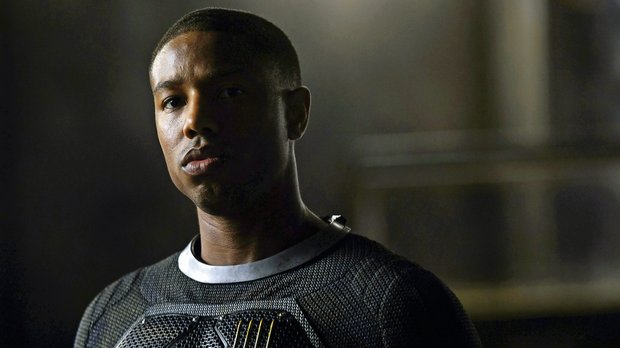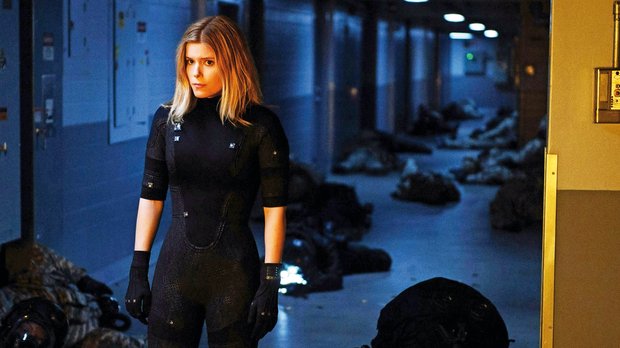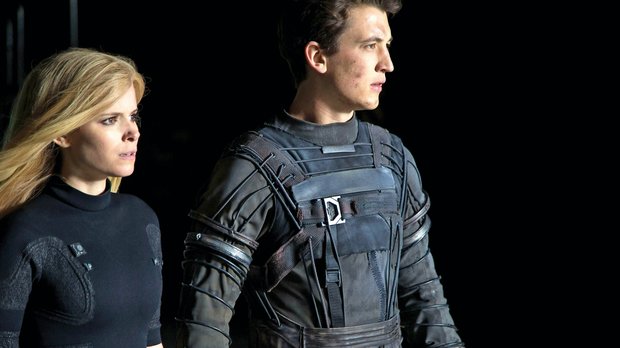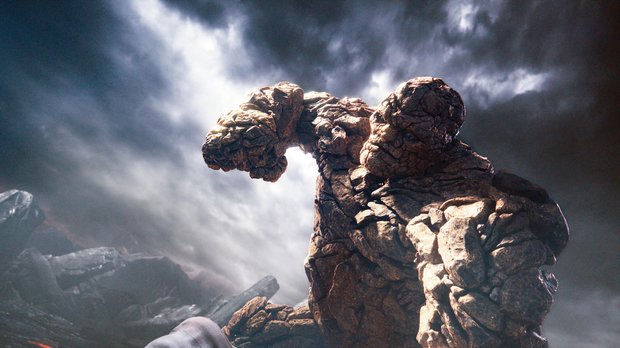The Fantastic Four's powers are more traumatic than super
Stan Lee always had an allergy to understatement. Grab any early issue of Fantastic Four and you’ll see the words “The World’s Greatest Comic Magazine!” slapped above the title logo. These comics may have been the crude, raw matter of the nascent Marvel Universe but Lee’s boast was more than just carnival barker hype. Teamed with artist Jack Kirby he unleashed a riot of page-melting imagination that powered a groundbreaking run of stories, cornerstone of the superhero craze that dominates today’s cinema screens.

We’re still waiting for The World’s Greatest Fantastic Four Film. Hollywood folklore insists a Marvel exec ritually torched the unreleased master print of 1993’s micro-budget embarrassment from exploitation king Roger Corman. Chris Columbus’s blockbuster vehicle for Dennis Quaid and Meg Ryan only exists in the Odeon of your dreams, playing on a double-bill with Peyton Reed’s 1960s-set version. Tim Story’s bright, goofy pair of mid-noughties FF movies actually made it to the screen but failed to ignite with fans.
Now Twentieth Century Fox is taking another stab at nailing the Fantastic Four. And this may be the boldest take yet, a darker, more grounded, altogether more unnerving riff on Lee and Kirby’s quartet of heroes. “One of the things we kept talking about was the word fantastic,” says Simon Kinberg, the film’s screenwriter and producer. “The previous movies had treated fantastic as a synonym for excellent or awesome. And we wanted to treat it more like when the word fantastic means fantastical, which is more science fiction, more horror to some extent. The way it was used in early genre literature was almost always in the scary sense of the fantastical. And that was a guiding principle for us.”

A core creative in Fox’s reborn X-Men franchise, Kinberg joined the project on the strength of director Josh Trank’s initial concept. Trank’s breakthrough hit was 2012’s Chronicle, an edgy, found-footage spin on the superhero myth. He had an equally radical vision for Marvel’s founding family. Superpowers? Try “aggressively abnormal physical conditions”.
“He had such a clear idea of how to make it fresh and relevant and modern without betraying what was classical about the comic books that I got off the phone with him and called the studio and said ‘I’m in’,” Kinberg tells SFX. “It was a stripped-down, emotional, relatable version of the Fantastic Four. He said – and this was emblematic of the whole approach – that when they are transformed and given their powers, instead of treating it like it’s a gift, like they suddenly have superpowers that they can go and utilise, it’s a curse. It’s how we’d all feel if suddenly our bodies caught on fire uncontrollably or we couldn’t control the elasticity of our limbs, or we turned into a rock creature or we couldn’t control our own invisibility. It would be terrifying. It would be a massive transition, a traumatic transition in our lives. And he wanted to explore that. I’d never really seen that done in any superhero movie.”
Trank’s Fantastic Four draws inspiration from equally unexpected sources. “The references he kept using were movies like Close Encounters and ET and David Cronenberg movies. Even though they were quite distinct from the comic and very different from the movies that had preceded it, it felt correct for the franchise. It didn’t feel like he was trying to twist it into something that it wasn’t.”
The movie’s marketing has positioned it at the bleaker end of the superhero spectrum. The first trailer traded the pop-art optimism of the original comics for a grim, Nolanesque tone and sombre, dystopian hues. Kinberg agrees that this is a darker, grittier take but argues that there’s light in there too. “It’s not a dour film,” he stresses. “It just treats it all a little more seriously than we’ve seen before. There’s still humour in the movie, and a lot of heart. One of the things that we embraced from the original comics that now seems sort of quaint but back in the day was pretty bold was the way they used science. They treated science like being a scientist was a heroic act. It was cutting-edge science. It was this moment in time around the space race where the world looked at scientists as leaders. We’re in that era again – it’s not space but it’s the internet, it’s new technology. We wanted to make it feel that science was real and bleeding-edge and next generation.”
Get sneak previews, exclusive competitions and details of special events each month!
Kinberg claims that’s not the only connection to the authentic spirit of Lee and Kirby. “We went back and looked at the original books and mined them for what we felt were the most integral parts of what defined the Fantastic Four. A lot of what Josh and I love about the Fantastic Four is the interpersonal family squabbles and that kind of humour, where it comes from the very mundane in the context of the fantastical. The reason that certain comic books penetrate the culture and remain favourites for decades is always the characters. And the Fantastic Four are no exception. They’re just four wonderfully drawn characters who are easy corollaries for our real lives. So we get into sibling rivalry, we get into best friendship, we get into a burgeoning love story.”

This team skews young, taking a cue from Marvel’s Ultimate Fantastic Four title, the twentysomething-themed reboot that debuted in 2004. “When I came on to the movie Josh had made the decision to make it an origin story and make the Fantastic Four younger,” says Kinberg, “partly following Ultimate and also because in many ways he saw this as a coming of age story, which it shares with Chronicle. And the FF’s transformation, for him, was a literalisation of that coming of age. To make them older, in their thirties or forties, would have taken away from what he wanted to do dramatically.”
Flaming on as Johnny Storm is Chronicle’s Michael B Jordan, a casting choice that shakes up the all-white status quo of the original comics. “The one person Josh knew he wanted to cast was Michael. They’re close friends and he just saw him as Johnny. Funny, charming, moves fast, just a very electric person in real life and on screen. We wanted someone who could be a superhero, so you feel like there’s a certain larger than life quality to them, but also someone who’s able to play real, grounded drama.
“Miles Teller was the person that we were really passionate about for Reed. Again he’s somebody who can be mischievous and playful – he’s sort of irrepressible and there’s a lot of that in the film – and yet also really heavy and intense. For Sue we wanted someone who was a little more mature than the other characters. It was important for us to cast someone who felt like she was legitimately a brilliant physicist and potentially even smarter than Reed. We looked at a lot of actresses who had that level of innate intelligence. Kate Mara’s somebody I’ve been a fan of for a long time.

“And then Ben was an interesting one,” Kinberg continues, recalling the search for an actor who could embody the rock-bound soul of Benjamin J Grimm aka the Thing, the mighty orange fists of the foursome. “The initial instinct was to cast a big, burly guy, as it’s been depicted in the past. We met with a bunch of those actors. And then Jamie Bell’s name came up and suddenly it became more interesting to cast against type and start with someone who’s not massive in size but who becomes massive, so the transformation’s even more dramatic in his life. Jamie has this tough, working class background – we’d seen him do it in Billy Elliot – so we felt like he’d be an interesting choice.”
The four face down Toby Kebbell as essential FF foe Doctor Doom. “Toby was someone we’d looked at for X-Men movies in the past and he fitted really nicely into Victor. We wanted to use Doom because he’s the classic nemesis and also because we liked the idea of starting the movie with a bunch of characters who were friends. They could almost have been the Fantastic Five if circumstances had gone differently. There was something really interesting about that, and emotional.”
Kinberg knows that this fearlessly 21st century take on a beloved comic book is a controversial proposition for some fans. “Yeah, I think it’s been a harder sell because the hardcore fans were not wild about the previous incarnations. So you always have to convince them that we’re doing something different than what they’ve seen before. And Fantastic Four is also, I believe a fundamentally difficult comic to adapt to a modern tone and a modern world. The fans are waiting to see what we do with it.

“The powers are tricky to render with visual effects – creating a rock creature who’s still dimensional and emotional has up until this point been very challenging. We really did a lot of research and development before we started making the movie to make sure that we’d be able to do justice to the Thing and not make him feel like he was either a cartoon or a suit like in the other movies. The same is true of Reed’s stretching ability – that’s a very challenging power to render. And then on the tonal side the original comics very much have the voice and tone of the era in which they were created. We wanted to stay true to a lot of the optimism of the original books and the aspirational quality of them, but we also wanted to modernise it. You want to be careful and respectful but also create a movie that is a great movie for audiences that may be meeting the Fantastic Four for the first time.”
Fox has faith. Fantastic Four 2 is already scheduled for summer 2017. The World’s Greatest Sequel? We’ll see. “We’ve been talking a lot about it,” teases Kinberg. “I think the biggest question – and this is the way I approach all these movies – is ‘What’s the next stage in the evolution of these characters?’ And at the end of this movie – I don’t want to give it away! – they’re at the place where they’re starting to embrace and accept who they are. And so the next movie would be the complexities of what it is to now be living with these powers in the real world. It’s almost like if this is a coming of age story for these characters, the next movie is about what it is to be a grown-up in the world…”
Click here for more excellent SFX articles. Or maybe you want to take advantage of some great offers on magazine subscriptions? You can find them here.

Nick Setchfield is the Editor-at-Large for SFX Magazine, writing features, reviews, interviews, and more for the monthly issues. However, he is also a freelance journalist and author with Titan Books. His original novels are called The War in the Dark, and The Spider Dance. He's also written a book on James Bond called Mission Statements.


